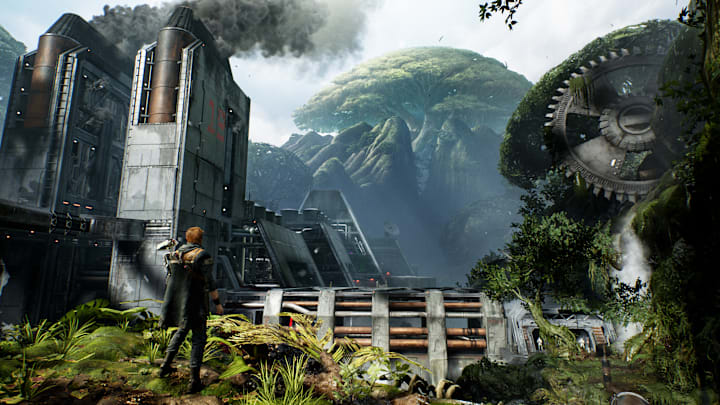Star Wars video games have been something of a mixed bag. The old farts among us remember when Knights of the Old Republic came out—and how amazing that was—but we also remember Kinect Star Wars. Yikes.
In more recent times, we've had a smattering of successes and failures, such as Battlefront II and LEGO Star Wars. As good (or bad) as you think those games were, nothing quite measured up to the storytelling of KOTOR.
Then in 2019, Respawn Entertainment dropped Jedi: Fallen Order, and something changed.
Here was a game that didn’t just let you swing a lightsaber—it made you feel the weight of carrying one after your entire life had been shattered. It didn’t just give you Force powers—it gave you the trauma, guilt, and resilience that come with surviving the worst day in Jedi history. By the time the credits rolled, Fallen Order had done something remarkable: it told a Star Wars story that could stand shoulder to shoulder with the franchise’s best.
A Hero’s Journey Done Right
At the time, Cal Kestis wasn’t your typical Star Wars game protagonist. When we meet him, he’s not a hotshot pilot or an overpowered Force prodigy—he’s a broken young man hiding in a scrapyard, keeping his head down after barely escaping Order 66. His story is a hero’s journey, and it starts from trauma, not glory.
And that makes the climb all the more satisfying. As Cal slowly reconnects with the Force, his growth feels earned. Every new ability isn’t just a gameplay upgrade—it’s a sign that he’s allowing himself to embrace being a Jedi again. The flashbacks to when he was a Padawan are an awesome way to show him regaining his confidence. Cal's slow reconnection with the force is something that could have been done far better in Disney+'s Kenobi series.
Cal Kestis's story is seriously one of the best things to come from Star Wars in recent years. Phenomenonally well written, with so much more of his arc to explore. pic.twitter.com/XWFIj37uNs
— Darth Thunder ⚡ (@XDarthThunderX) August 9, 2025
When Gameplay and Story Work Together
Plenty of Star Wars games have great mechanics, but few make them part of the story. In Fallen Order, everything you do—meditating to save progress, solving environmental puzzles, mastering timing in combat—feels thematically tied to Cal’s journey.
Take the lightsaber forge sequence on Ilum, for example. Mechanically, it’s just a customization moment. You get a few new abilities, and kind of a new stance (real dual-wielding doesn't come until Jedi Survivor). Emotionally, it’s a gut-wrenching scene of failure, perseverance, and renewal. You’re not just picking a blade color—you’re watching Cal choose to be a Jedi again. And when the game gives you control in that moment, it’s more powerful than any cutscene could be.
Side Characters Who Matter
Cere Junda might just be one of the most complex Jedi we’ve ever seen outside the films—or even including them. She’s a mentor to Cal, yet she's carrying her own failures, walking the line between light and dark after making impossible choices in her past. And who doesn't love Greez, the grumpy pilot with a gambling problem who somehow becomes the beating heart of the crew. Then there’s the Second Sister—Trilla—a villain so layered that by the end, you’re not sure whether to hate her or mourn her. Her arc is nearly as complex as Cal's.
Better yet, the game takes its time letting these relationships breathe. Banter on the Mantis between missions, quiet moments of reflection, and shared victories all make this ragtag group feel like a real found family—one that earns your emotional investment.
As Cinematic as Star Wars Gets
The production quality here is on par with the films. The cutscenes blend seamlessly into gameplay, the animation is fluid, and the lighting could fool you into thinking you’re watching a new Disney+ series. And then there’s that ending. Without spoiling too much (though the game is six years old), the final encounter with Darth Vader is pure Star Wars terror. It doesn’t turn him into a boss fight—Cal grows through the game, but he's not about to take on Vader. Instead, it turns the Sith Lord into an unstoppable force of nature, reminding players exactly why the galaxy feared him. The restraint in that scene is exactly what makes it unforgettable.
Fallen Order proved that single-player, story-driven Star Wars games still have a place in modern gaming. Its success paved the way for Jedi: Survivor and Outlaws, both of which leaned more into the gritty, story-driven style. And with the current appetite for narrative-rich experiences, it’s not hard to imagine Fallen Order influencing future Star Wars films, shows, and novels.
Jedi: Fallen Order didn’t just set a new bar for Star Wars games—it reminded us what Star Wars storytelling could be when it trusts its characters, takes its time, and isn’t afraid to make the Force feel personal again.
It’s not just about the lightsaber duels, the set pieces, or even the nostalgia. It’s about a young man finding the courage to face his past, a crew learning to trust one another, and a galaxy still trying to heal from its deepest wound. If the future of Star Wars looked more like this—carefully crafted, emotionally resonant, and unafraid to be intimate—we might just find the galaxy is in very good hands.
